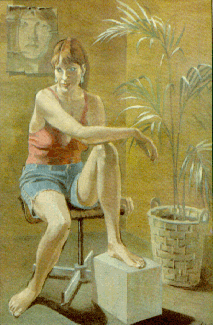It is the figure - ever-elusive, ever-fascinating, and ever-challenging - that keeps Toledo artist Adam Grant inspired, just as it has inspired artists over the centuries.
By Louise Bruner TOLEDO Magazine, June 10-16, 1990
ART actually saved the life of Adam Grant.

As a Polish prisoner in Auschwitz and other German concentration camps in World War II, he drew the attention of the guards by his sketches of the other 10 inmates of his cell. They wanted greeting cards for their sweethearts, so "I drew roses and butterflies for men who could have killed me at any time," he said.
As a reward, they gave him soap or cigarettes which he could use for trading, but most importantly, they gave him the extra food that kept him from starving to death.
At the war's end, he was sent to Munich as a displaced person, and there he waited five years for the chance to emigrate to America. He used his waiting time to design stage sets for amateur theatricals and to create cubist-type abstract designs in black and white.
Through the United Nations Relief Organization, he was sent to Detroit through the generosity of a sponsor he never met. "We both took a chance on each other," he said.
Although he had never worked in oil paint, he took lessons at the Detroit Society of Arts and Crafts, and soon after, landed a job with the Palmer-Pann Corp., the worId's largest producer of paint-by-number panels. In 1956, the firm moved to Toledo, and Grant came along.
His assignment was to create pictures that would be transferred to canvas panels for others to color and finish as their own. During the heyday of this fad, millions were sold.
Horses, dogs, mountain landscapes, rushing streams, and autumn sunsets were favorite themes, and only rarely did he include a figure.
But since he left commercial art to devote full-time to his own work, he has concentrated on the female figure. He presents her in a variety of poses, seated, with legs fIexed, standing, sitting, or reclining; singly or in pairs; wearing acrobat tights or nothing at all, except draperies. Background props are kept to the minimum and they are carefully selected to keep visual interest moving throughout the surface.
Expressions on the faces of his figures are detached and remote, and this is by intent. He is neither trying to express himself through distortions nor is he concerned with the models' problems, emotions, and personality.
It is the figureÑever-elusive, ever fascinating, and ever-challenging that keeps him inspired, just as it has inspired artists over the centuries.
Grant recalIs the exact moment he decided to be a figural artist when he was a boy of 10 in Poland. His father, a physician and amateur painter, gave him a book of Michelangelo's drawings, and they impressed him so deeply, he has never wavered in his decision.
His working methods are sIow and thorough. He begins with a quick sketch, setting the pose, and then deciding what elements are still needed in the overall composition. He uses photographs as references for the details of a chair or a plant or the action of sunlight and the resulting shadows on the figure.
When these problems are solved, he makes a final drawing to scale and transfers it to canvas. During the act of painting, he often paints a small duplicate on which to try out colors or make changes. His thin oil medium permits him to rework the pigment up to two or three days. Then the painting is varnished and the drying period lasts as long as six months.
With commissioned portraits, he offers two or three sketches as suggestions for an acceptable pose. Recently, he painted a group portrait of a mother and two children. "I didn't want them lined up in a row on the sofa, so I had the oldest daughter, a dancer, wear her frilly costume and take a pose on the floor in the foreground. It was perfectly natural for her to assume such a casual pose, and it served to unify the composition," he said. The compositional unity of the painting guides his declslons.
One of the acid tests - the skill of any artist is his ability to draw hands and feet. Despite their deceptive simplicity, they are extremely subtle and elusive, adding or detracting from the overall characterization. Grant gives them full attention.
Over the years, he has grown steadily and slowly in stature, rendering his figures in a three-dimensional fluidity with color establishing the forms. His dedication to his life-time goal is rarely seen in today's art world, where many artists indulge in unrestrained freedom at the expense of mastering their craft.
Grant has exhibited in 32 Toledo Area Artist - Annual exhibitions, winning first awards and the Roulet Medal for excellence.
He has been a veteran exhibitor in shows at Ohio State Fairs and the National Midyear Exhibitions at the Butler Institute of American Art in Youngstown. His work is carried by the Chapman Art Gallery, Sylvania; the Oehlschlaeger Galleries, of St. Armand's Key, Florida; Capricorn Gallery, Bethesda, Md., and Button Galleries of Douglas, Mich., where he will have a one-artist show beginning on Memorial Day. His home and studio are located at 2821 Latonia Blvd.